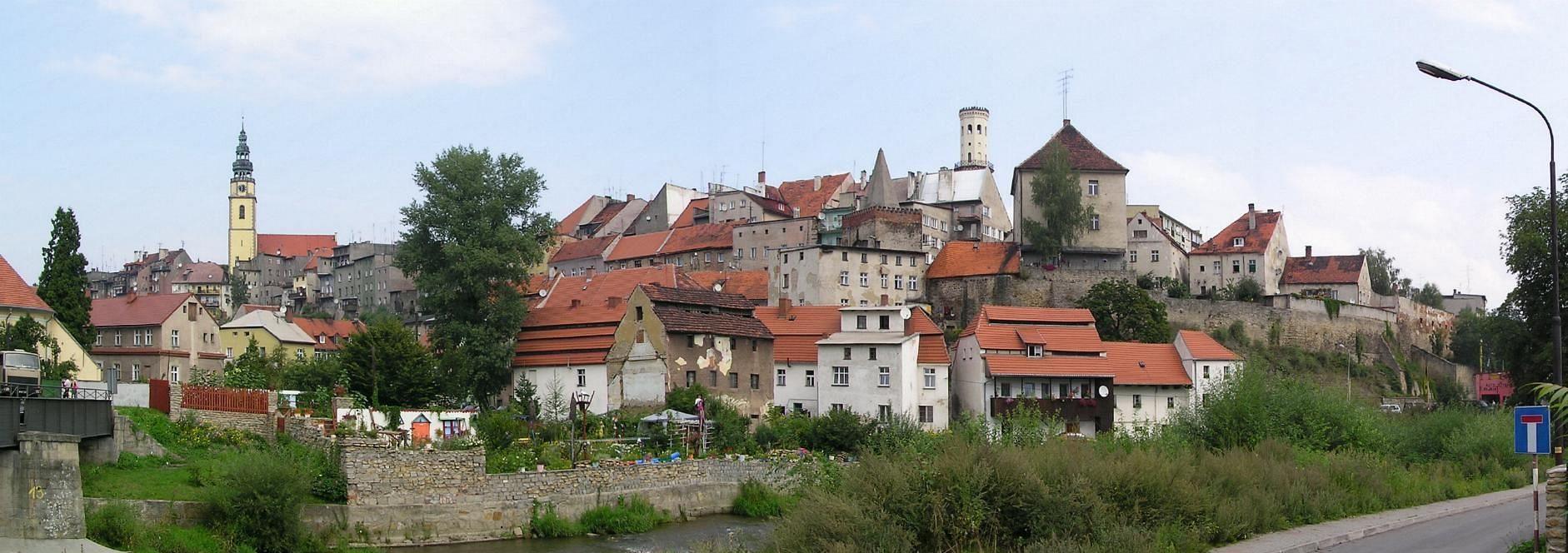- Bystrzyca Kłodzka
Infobox Settlement
name = Bystrzyca Kłodzka

imagesize = 250px
image_caption = Town panorama
image_shield = POL Bystrzyca Kłodzka COA.svg
pushpin_
pushpin_label_position = bottom
subdivision_type = Country
subdivision_name = POL
subdivision_type1 = Voivodeship
subdivision_name1 = Lower Silesian
subdivision_type2 = County
subdivision_name2 = Kłodzko
subdivision_type3 =Gmina
subdivision_name3 = Bystrzyca Kłodzka
leader_title = Mayor
leader_name = Renata Lucyna Surma
established_title = Established
established_date = 11th century
established_title3 = Town rights
established_date3 = 13th century
area_total_km2 = 10.74
population_as_of = 2006
population_total = 10638
population_density_km2 = auto
timezone = CET
utc_offset = +1
timezone_DST = CEST
utc_offset_DST = +2
latd = 50 | latm = 18 | lats = | latNS = N | longd = 16 | longm = 39 | longs = | longEW = E
elevation_m = 340
postal_code_type = Postal code
postal_code = 57-500
area_code = +48 74
blank_name = Car plates
blank_info = DKL
website = http://www.bystrzycaklodzka.plBystrzyca Kłodzka [IPA-pl|b|y|s|'|t|sz|y|c|a|-|'|k|ł|o|c|k|a] ( _de. Habelschwerdt, _cs. Kladská Bystřice) is a city in the
Lower Silesian Voivodeship inPoland . It is famous for its historical buildings and is a tourist centre. It has a population of 12,000 and is located on theNysa Kłodzka andNysa Łomnicka rivers.Geography
Bystrzyca Kłodzka lies near the
Kłodzko Valley , at the feet ofSudetes . It is located at the junction ofNysa Kłodzka andBystrzyca Łomnicka rivers.History
The area of today's Bystrzyca Kłodzka has been inhabited at least for 6 millennia. During the times of the
Roman Empire theCelts have established numerous permanent settlements in the area of GlatzKłodzko on theAmber Road . There are also numerous archaeological excavations ofLusatian culture remnants in the area.The German town of Habelschwerdt was founded by Gallus of Lämberg (
Havel of Markvartice ) next to a Slavic village on the trade route leading through theSudetes in mid-13th century. It was granted the so-calledWestern Law (a variant of theMagdeburg Law ). OnJuly 4 ,1319 , John of Luxemburg, king of the Romans (ofHoly Roman Empire ), later king ofBohemia , granted the village vast autonomy and a right to constructcity walls . The first noted mayor of Habelschwerdt wasJakob Rücker . The town was constructed almost from scratch. First the city walls were erected with three gates and several towers. Then the Market Square was planned on a slope and the Mayor House was constructed. Most of theGothic architecture was preserved and the town is now considered one of the classical examples of Mediaeval architecture. The town started to grow rapidly. It was granted with several otherprivilege s, among them the right to trade withsalt ,spice s and fabric.The town initially belonged to the "Grafschaft Glatz"
Duchy of Kłodzko , a fief ofBohemia . It shared the fate of the nearby city of "Glatz"Kłodzko and developed rapidly until the advent of theHussite Wars in 15th century. The wars left the town depopulated by plagues, partially burnt and demolished by several consecutive floods. In 1475 a great fire destroyed the town completely. In 1567 the area became a fief of theHabsburg dynasty, though the local dukes retained their powers. It was not until 16th century when the local economy went back on tracks. Both Habelschwerdt and the surrounding villages were gradually repopulated, mostly with settlers from CentralGermany andLesser Poland . Because of major Lutheran influences it became one of the regional centres ofProtestantism .In late 16th century the new
City House was built and many of the houses were rebuilt inRenaissance style. The town also built several facilities like paved roads andsewer system. However, theThirty Years' War and other conflicts of thecounterreformation damaged the city and ended the period of prosperity. OnFebruary 14 ,1745 ,Prussia n generalHans von Lehwaldt defeatedAustria n forces ofGeorg Oliver von Wallis near the city. During theSilesian Wars Habelschwerdt (together with most ofSilesia ) came underPrussia n rule.Soon afterwards it was captured by forces of
Napoleon Bonaparte and housed a Frenchgarrison until 1815, when it returned to Prussia. Although it was made acounty capital in 1818, it was also struck by hightaxes . It was not until mid-19th century when the city fully recovered. The City House was yet again rebuilt, the citymoat and parts of thecity walls were levelled and the city expanded into new areas. After 1877 "Habelschwerdt" Bystrzyca was connected to "Glatz" (Kłodzko ) and "Breslau" (Wrocław ) by a railroad. In 1885, Habelschwerdt had a population of 5,597, while by 1939 it rose to 6,877.End of the 19th century saw the whole Glatzer Tal (
Kłodzko Valley ) turned into one of the most popular tourist regions. Countlesshotel s, sanatoria and spa were opened to the public in the nearby towns ofKłodzko (then "Glatz"),Duszniki Zdrój (then "Bad Reinerz") andLądek-Zdrój (then "Bad Landeck"), as well as in the town itself. The area of former Duchy became a popular place among the rich bourgeoisie ofWrocław ,Berlin ,Vienna andKraków .During
World War II Habelschwerdt was spared the fate of other German cities that were levelled to the ground. There were no important industrial centres in the area and most of theKłodzko Valley was not captured by theRed Army until after the capitulation ofGermany . Shortly after the war the Kłodzko Valley became a scene ofWehrwolf activities. Following thePotsdam conference the town was awarded toPoland as compensation for the areas of Poland annexed by theSoviet Union in the east. The German inhabitants of the area and wholeSilesia were expelled by the new authorities.Between 1975 and 1998 Bystrzyca belonged to the
Wałbrzych Voivodeship . It continued to be one of the principal mountainresort s of the area. Thanks to its historical landmarks as well as virgin landscapes, Bystrzyca Kłodzka remains one of the most popular centres oftourism andwinter sports inLower Silesia .Twin towns
Alcañiz ,Amberg ,Kazmierz Wielkopolski ,Laissey ,Usti nad Orlici ,Wolkowysk ,Zuidwolde References
External links
* [http://www.bystrzyca.info.pl/ bystrzyca.info.pl]
* [http://www.bystrzycaklodzka.pl/ bystrzycaklodzka.pl]
* [http://www.bystrzyca.pl/ bystrzyca.pl]
Wikimedia Foundation. 2010.

